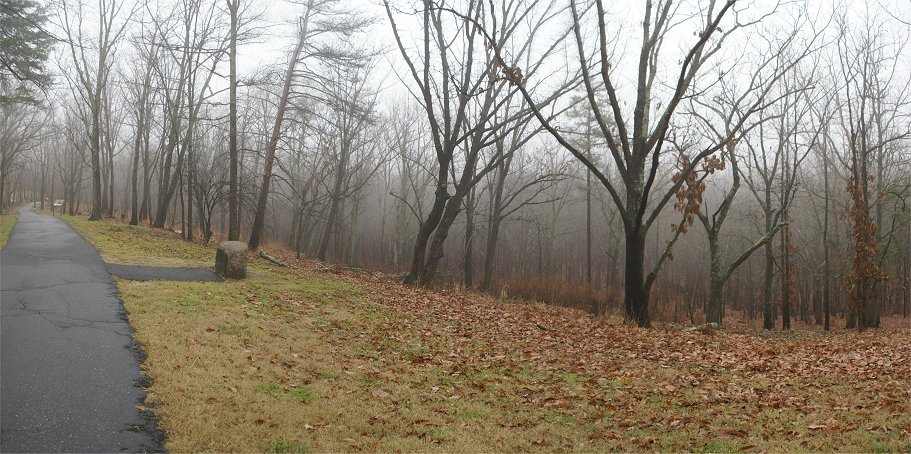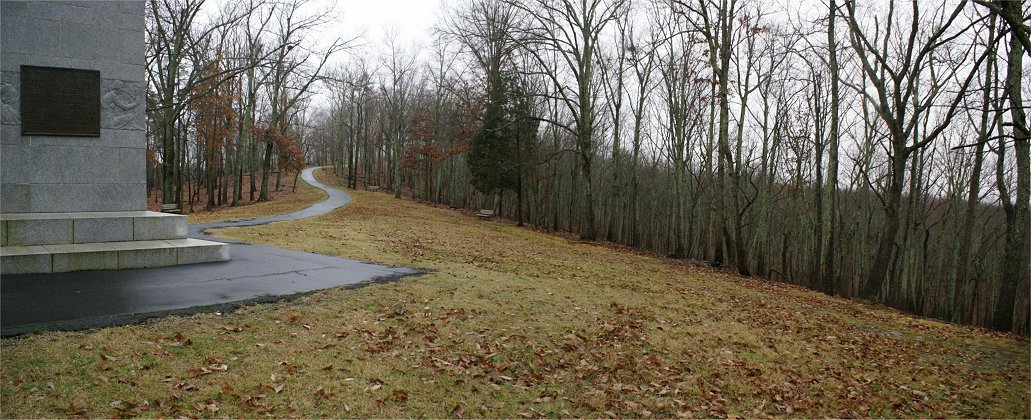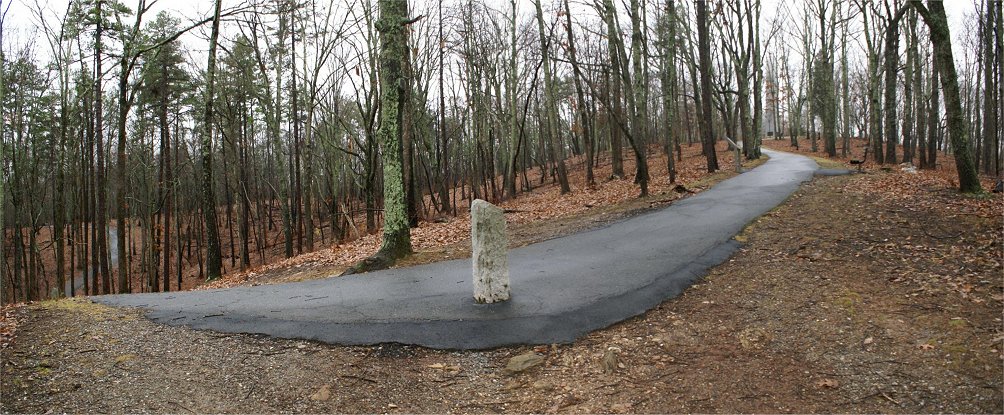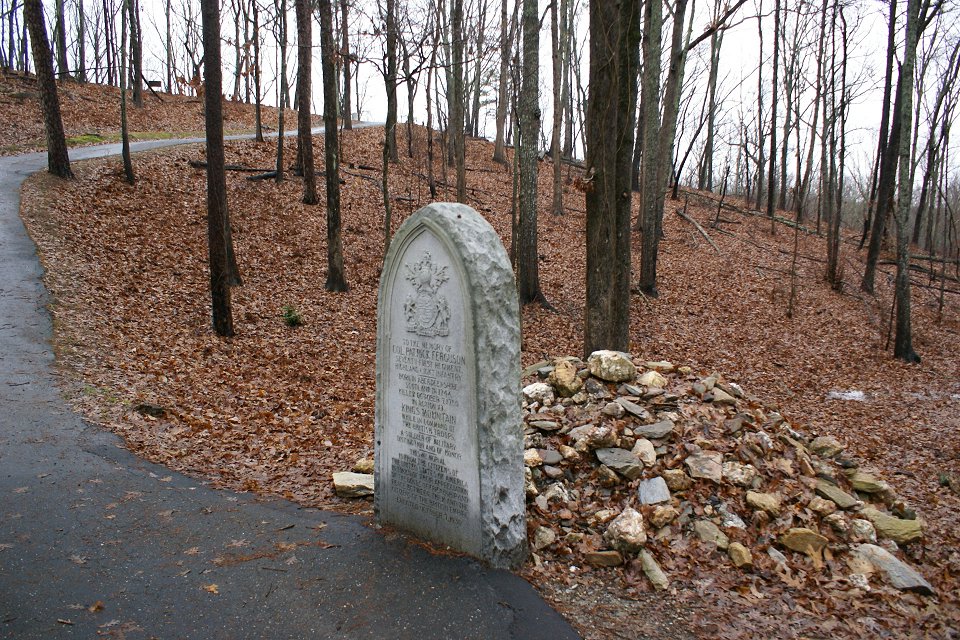Kings Mountain
October 7, 1780
With the near destruction of an American army at Camden,
South Carolina in August 1780,
the whole colony was occupied, and there was little to stop a British
invasion of North Carolina in the
fall of 1780. Cornwallis, commanding the offensive, would advance
on Charlotte, NC and Salisbury from Camden. He expected a Tory
rising in
eastern North Carolina to capture that portion of the colony, and to
the west, he expected a column of Tories under the command of Maj.
Patrick Ferguson, from Edinburgh, Scotland, to subdue the settlements
across the mountains.
Eventually, Cornwallis would continue into Virginia and meet up
with 2,500 British troops sent there from New York City.
If everything went according to plan, the entire South, from
Georgia to Virginia, would come back under British control.
Cornwallis reached Charlotte on September 26th and halted
after a skirmish there to wait for Ferguson to join him. He
never would.
Ferguson had been moving north from Ninety Six, SC starting in July,
reaching Gilbertown, NC on September 23rd. He had been
facing militia under Col. Charles McDowell, who called for help from
over the mountains. It would soon be coming. Ferguson had
sent a paroled militiaman back home across the mountains
with a message. Ferguson ordered the 'over mountain men' to
accept British soveriegnty. If they didn't, Ferguson would
'march his army over the mountains, hang their leaders, and lay
waste to their country with fire and sword.' Ferguson would have
been better served to use more carrot and less stick. His threat
only served to encourage more men to join the rebel cause.
The force
organized against Ferguson was composed of men from South
Carolina, North
Carolina, Tennessee, and Virginia, approximately half of them
from over the mountains, and they elected William Campbell of Virginia
as their commander. By September 27th, Ferguson was falling back
to the south,
and on October 1st, he changed course - to the east- heading
toward Charlotte to join
Cornwallis. Ferguson sent two requests for reinforcements, but
none would arrive. The patriots, camped at Hannah's Cowpens, got
a report that Ferguson was camped at King's Mountain. On
October 6th, 900 of their roughly 1,400 to 1,790 men were selected and
sent east on horseback. By the afternoon of October 7th,
they reached Kings Mountain.

This is the view from the eastern, or lower, end of the mountain, which
at its highest is around 200 feet higher than the land below. The
leaf covered trail on the left is the trace of the road that the
patriot force approached on from the south, or the upper left of the
panorama. Catching the Tories by surprise, they moved along
either side of the mountain, visible in the center of the panorama, and
surrounded Ferguson's 1,100 men. On the northern side of the
mountain, visible here, the patriot line formed roughly parallel
to the paved trail that extends to the right. The short uphill
trail is to the William Chronicle Monument, named for one of the
patriot leaders.

This is the view from the paved trail further west, where men
under Sevier fought. The highest portion of mountain is visible
here. William Campbell's Virginians were to
the right of Sevier on other side of mountain.

This is the view up the western end of the mountain. Sevier
attacked the summit from the left of the panorama while Campbell
attacked from the right.
Earlier in the war, Ferguson had developed a breech loading,
quick-reloading rifle and commanded a corps of riflemen equipped with
his invention. Now he commanded men equipped with muskets who
were
surrounded by riflemen. The musket had the advantages of being
quicker
to fire while also mounting the bayonet, a weapon that patriot militia
in open ground typically feared. In this case, however, the
rocky,
forested slopes hindered the bayonet charge and gave cover to the
riflemen, who, although they had a slower rate of fire, had better
accuracy and cover from which to fire. Firing uphill is more
accurate than firing downhill, giving a further advantage to the
attackers
Although the Tories charged with the bayonet, the patriot riflemen
would simply fall back down the mountain then return after the Tories
returned to the summit. Eventually, the Patriots gained the
summit.

This is the view from the crest, which the trail follows, below the
summit. This is the Tory view down the southern slope,
where Campbell and McDowell's men attacked. The Tories,
taking fire from both sides of the crest and now pressured from patriot
riflemen on the summit, were forced down to the eastern end of the
crest.

In this area, where the US Monument was built, Ferguson's men made their final stand.

This is the view from the US Monument, looking along the ascending
ridgeline toward the summit, now in patriot hands along with the slopes
on all sides.

The US Monument marking the site of the last stand is visible on
the right, just above the paved trail. Ferguson had been active
all day, rushing around the mountain crest on his horse, ordering
bayonet charges and encouraging his men. When he saw his men
raise white flags of surrender, he cut them down. In a last,
desparate effort, he led his men down the slope in an effort to break
out. Here, where the stone pillar now stands, he was shot
dead, hit with seven bullets simultaneously. With their leader
dead, the Tories surrendered, or tried to. The patriots, having
heard stories of Tarleton's Quarter at Waxhaws and remembering
Ferguson's threats, were not in the mood to take prisoners.
Evenually, though, the firing stopped, and roughly 700 of the
1,100 Tories were taken into captivity. Atrocities were committed, and the relatively high
percentage of Tory killed to wounded suggests as much. While being
marched into captivity, several more prisoners would be killed,
and several more were hanged after being put on trial.
In the hollow, visible on the left of the panorama, Patrick
Ferguson was buried under a cairn of stones. Some sources
state that his body was mutilated. The
area is just uphill from the site of the first panorama, near
the Chronicle monument.

Ferguson had been killed where you see the modern paved trail
disappear along the crest. Ferguson's body was dragged downhill
to this site and buried under a pile of stones.
The grave also contains the body of his mistress,
a Tory camp follower.
The battle had taken just over an hour to fight. With less
than 100 patriots killed or wounded, Kings Mountain was a decisive
tactical victory by any measure, but the battle would also have
important strategic implications; Cornwallis called off his
invasion of North Carolina, and the expedition to Virginia was diverted
to South Carolina. This gave the American southern army time
to rebuild and get a new, commander, Nathanael Greene,
selected by George Washington for his competence. In the words of
Sir Henry Clinton, the battle of Kings Mountain started a chain of events
disasterous to the British cause. The next link in that chain
would come in January, when another 1,000 man detachment
would be smashed at the battle of Cowpens.







